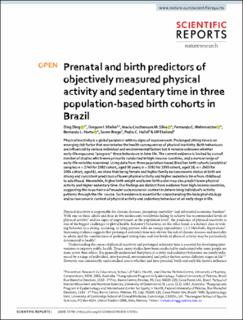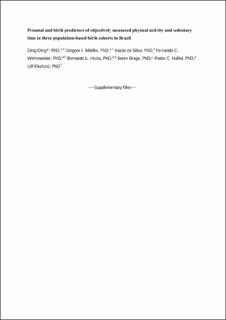| dc.contributor.author | Ding, Ding | |
| dc.contributor.author | Mielke, Gregore I. | |
| dc.contributor.author | Silva, Inácio Crochemore M. | |
| dc.contributor.author | Wehrmeister, Fernando César | |
| dc.contributor.author | Horta, Bernardo L. | |
| dc.contributor.author | Brage, Soren | |
| dc.contributor.author | Hallal, Pedro C. | |
| dc.contributor.author | Ekelund, Ulf | |
| dc.date.accessioned | 2021-03-20T08:15:15Z | |
| dc.date.available | 2021-03-20T08:15:15Z | |
| dc.date.created | 2021-02-01T13:54:35Z | |
| dc.date.issued | 2020 | |
| dc.identifier.citation | Scientific Reports. 2020, 10(2020), Artikkel 786. | en_US |
| dc.identifier.issn | 2045-2322 | |
| dc.identifier.uri | https://hdl.handle.net/11250/2734589 | |
| dc.description | This article is licensed under a Creative Commons Attribution 4.0 International License, which permits use, sharing, adaptation, distribution and reproduction in any medium or format, as long as you give appropriate credit to the original author(s) and the source, provide a link to the Creative Commons license, and indicate if changes were made. Te images or other third party material in this article are included in the article’s Creative Commons license, unless indicated otherwise in a credit line to the material. If material is not included in the article’s Creative Commons license and your intended use is not permitted by statutory regulation or exceeds the permitted use, you will need to obtain permission directly from the copyright holder. | en_US |
| dc.description.abstract | Physical inactivity is a global pandemic with no signs of improvement. Prolonged sitting time is an emerging risk factor that exacerbates the health consequences of physical inactivity. Both behaviours are influenced by various individual and environmental factors but it remains unknown whether early-life exposures “program” these behaviours in later life. The current evidence is limited by a small number of studies which were primarily conducted in high-income countries, and a narrow range of early-life variables examined. Using data from three population-based Brazilian birth cohorts (analytical samples: n = 2740 for 1982 cohort, aged 30 years; n = 3592 for 1993 cohort, aged 18; n = 2603 for 2004 cohort, aged 6), we show that being female and higher family socioeconomic status at birth are strong and consistent predictors of lower physical activity and higher sedentary time from childhood to adulthood. Meanwhile, higher birth weight and lower birth order may also predict lower physical activity and higher sedentary time. Our findings are distinct from evidence from high-income countries, suggesting the importance of broader socioeconomic context in determining individual’s activity patterns through the life- course. Such evidence is essential for understanding the biological etiology and socioeconomic context of physical activity and sedentary behaviour at an early stage in life. | en_US |
| dc.language.iso | eng | en_US |
| dc.subject | epidemiology | en_US |
| dc.subject | risk factors | en_US |
| dc.title | Prenatal and birth predictors of objectively measured physical activity and sedentary time in three population-based birth cohorts in Brazil | en_US |
| dc.type | Peer reviewed | en_US |
| dc.type | Journal article | en_US |
| dc.description.version | publishedVersion | en_US |
| dc.rights.holder | © The Author(s) 2020 | en_US |
| dc.source.pagenumber | 12 | en_US |
| dc.source.volume | 10 | en_US |
| dc.source.journal | Scientific Reports | en_US |
| dc.source.issue | 2020 | en_US |
| dc.identifier.doi | 10.1038/s41598-019-57070-x | |
| dc.identifier.cristin | 1885082 | |
| dc.description.localcode | Institutt for idrettsmedisinske fag / Department of Sports Medicine | en_US |
| dc.source.articlenumber | 786 | en_US |
| cristin.ispublished | true | |
| cristin.fulltext | original | |
| cristin.qualitycode | 1 | |

